Foam rollers. Most people that use them have a love-hate relationship with them.
But what actually are they? Well, they pretty much are what they say on the tin: cylindrical pieces of foam and/or textured plastic that rolls on the floor, wall or wherever you might be using it. Foam rolling is an ‘SMR’ self-myofascial release - essentially helps to release tension from the muscles. Some claim it can help with mobility, injury recovery, DOMs (delayed muscle onset soreness), tightness and inflammation.
But how do you know if it’s right for you and how do you go about getting started? Here you’ll get to grips with whether you need a foam roller, which to opt for and how to get started.
How do foam rollers work?
Your foam roller essentially works like the hands of a physio - adding pressure to your muscle and trigger points that initially may feel uncomfortable but can help to ease any feelings of tightness. Foam rolling is encouraged for any areas of the body that feel tight or that you may have worked that day. Put the foam roller on a flat surface (usually, the floor but it can also be used on the wall for upper body or back release). Rest it between the muscle you’re looking to release the tension from and the hard surface. ‘Roll’ back and forth, stopping at points that feel particularly sore or tight. This can be useful either after a session to potentially help with muscle soreness or preventatively to ‘warm up’ and engage the muscle.
Despite foam rolling being a technique used by athletes and casual gym-goers alike, there is not a clear consensus of what foam rollers really do in terms of benefits - apart from the anecdotal claim of relieving tightness. However other benefit claims include:
- Injury prevention1
- Can improve flexibility2
- Improved performance3
- Increased range of motion4
But foam rollers should never be a replacement for consistent stretching and potentially the help of a health professional if needed. If you’re injured foam rolling likely won’t solve the issue alone.
Choosing the best foam roller for you
Now you’ve got the 411 on how and when to use a foam roller, let’s look at the different types. There are a few options to consider when picking the right piece of kit for you. Consider…
- Firmness: the firmer the foam roller the deeper tissue it will engage. And more potential pain initially.
- Length: shorter foam rollers are better for targeted areas whereas long foam rollers can be used across bigger muscle groups.
- Texture: smooth or bumpy. Some foam rollers are specifically designed with bumps that can really dig into trigger points.
We would recommend starting off with a softer and smooth foam roller - just to get used to the motion and feeling of it on your muscles. Then, once you’ve acquainted yourself, maybe upgrade to a firmer or different textured foam roller.
Using your foam roller to benefit your training
Much like stretching or other forms of muscular ‘release’, there isn’t necessarily a limit on the number of times you should foam roll. Generally, we would recommend sitting around the 1-3 times a day mark. This can all depend on whether you’re working out that day and your daily routine. A great way to include foam rolling is by adding it to your warm-up, cool down or generally when relaxing e.g. watching TV in the evening.
Also, as we said before, your foam roller should be used on the muscle you’re looking to use or is sore. For weightlifters, this might be more obvious, with your chest being a target after a heavy bench press or being used on the quads before a big leg day. For other forms of training really think about the muscles that need attention - for runners that might be calf muscles or rowers it might be your back. Really tap into what your muscles need and areas that feel sore.
Hopefully, this has given you a clearer idea of what a foam roller is and how you use them. To find out more info on sports performance, check out our blog. Or, if you’re looking to get your hands on a foam roller yourself, take a look at our range.
References
- Johannes Fleckenstein et al, ‘Preventive and Regenerative Foam Rolling are Equally Effective in Reducing Fatigue-Related Impairments of Muscle Function following Exercise’, Journal of Sports Science & Medicine (2017) [online] [Available at: https://www.ncbi.nlm.nih.gov/pmc/articles/PMC5721176/]
- Brandon Behara and Bert H. Jacobson, ‘Acute Effects of Deep Tissue Foam Rolling and Dynamic Stretching on Muscular Strength, Power and Flexibility in Division I Lineman’, The Journal of Strength and Conditioning Research (2017) [online] [Available at: https://journals.lww.com/nsca-jscr/fulltext/2017/04000/Acute_Effects_of_Deep_Tissue_Foam_Rolling_and.3.aspx]
- Kellie C Healey et al, ‘The effects of myofascial release with foam rolling on performance’, Journal of strength and conditioning research (2014) [online] [Available at: https://pubmed.ncbi.nlm.nih.gov/23588488/]
- Israel Halperin et al, ‘Roller massager improves range of motion of plantar flexor muscles without subsequent decreases in force parameters’, International journal of sports physical therapy (2014) [online] [Available at: https://pubmed.ncbi.nlm.nih.gov/24567860/]

